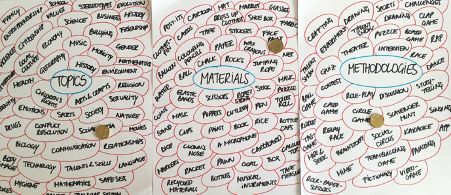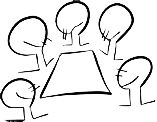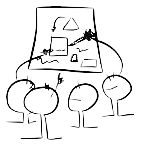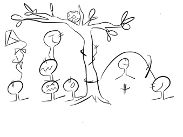Create your own games
You want to create new games yourself but you don’t really know how to get started? Below, we list one possible methodology you can follow to develop new games and activities. Good luck and have fun!
Step 1
You need...

Take three pieces of (flipchart) paper and some markers.
Step 2
Prepare

On the first paper, write “Topics” in the middle. Is there a specific topic you want to develop panels on, for example, the environment or local culture? Then, write that specific topic in the middle instead. On the second paper, write “materials” in the middle and on the third, write “methodologies”.
Step 3
Associate

Now, let’s associate away! On each piece of paper, write down all the things you can associate with the word in the middle. Possible topics for new panels or activities with the kids could be the environment, the solar system, culture,… Possible materials: pens, paper, chalk, colouring pencils, a jumping rope, a ball,.. and possible methodologies: theatre, role-play, an interview, a contest,…
Get your association juices flowing and fill up the papers. Don’t overthink and just write down everything that pops into your head. In the end, you’ll have three beautiful flowers.
Step 4
Throw a coin

Put the three flower associations on a table or on the floor and throw a coin or a bottle cap on each flower association to get a combination of a topic, a methodology and a material. If you’re doing this with your team, divide the team into different groups, who each throw their own combination.
Step 5
Brainstorm

Come up with game ideas with your combination. Take some time to brainstorm about the different possibilities. Be creative and don’t limit yourself to the three things you threw. If you have “string” as material, you can also use the strings of a guitar and create a song, for example.
Step 6
Pitch

If you’re working in different groups, each group can pitch their game concept(s) to the other groups, so you can give each other feedback and challenge each other to create the best game possible for your target group.
Step 7
Feedback

Based on the feedback of the other groups, further develop your game concept and create your panel and/or the materials needed to play your game.
Step 8
Let's play!

Play your game during your next session and gather the most important feedback of all: the feedback of your target group. Afterwards, take the time to discuss how the game went with your team and make the final adjustments.
Step 9
Sharing is caring =)

Share your brand new game on the StreetSmart Play platform so youth workers and street educators worldwide can play your game as well.
Don’t know how to share games on this platform yet? Check out the “Getting started” Tutorial!
